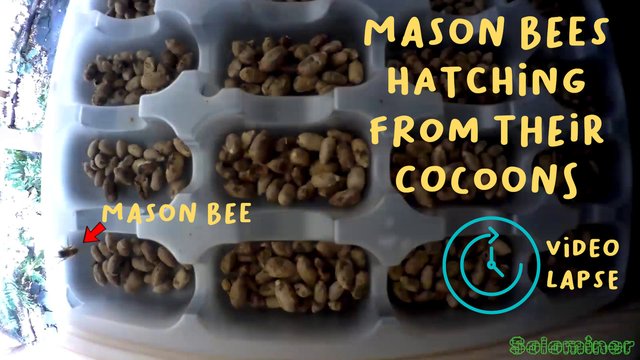
In the beginning of the video, Bees can be seen crawling around the trays I laid the cocoons in. I set my camera up and recorded all day using video lapse. By half way through the video I did not see any others emerge but there were a few in the beginning of the video that can be seen. By the end of the day we were losing light and I cut the footage at that point. That gave me about two minutes of video lapse footage.
When day time temperatures get above 55 Fahrenheit, the weather triggers the solitary Bees to emerge from their protective cocoons. It takes the larva all summer and fall to pupate within their mud cells and transforms into an adult bee over the winter and early spring.
I process the cocoons from the homes, removing the mud covering the cocoons. And place the cleaned cocoons in the refrigerator to keep them dormant until we get steady 55F days. Sometimes we get a warm streak but then quickly returns into winter climates. So I do not want the Bees to emerge too early just to be wiped out by the cold. So when I think we should be done with the bad frosts, I take them out of the refrigerator and place them in trays. I take these plastic trays, formerly food containers and place them outside by the homes I made for them. As the day warms up the Bees start making their way out of the cocoons and take their first flight.
I do apologize for the spotty light in this video lapse footage. It was a partly cloudy day, making it go from full sun to overcast constantly throughout the day. This caused the video lapse footage to vary. I did not want to set up a light, as it distracts the Bees and could cause problems. Maybe next year we will get a brighter day for them to hatch. Since this is video lapse there is no audio, so I added some music to fill the audio track. Music is credited at the end of the video.
LBRY Video Link
Addresses below to help me buy better camera equipment and support me to travel to locations to do photo and video and overall great blogs in new places. I would be happy to list some of the contributors in my posts for donations that help me along the way.
| Coin | Address |
|---|---|
 BTC: BTC: | bc1qhfmvd2gywg4fvrgy2kkkkyqta0g86whkt7j8r7 |
 LTC: LTC: | ltc1qdyzm5cwgt8e2373prx67yye6y9ewk0l8jf3ys9 |
 DASH: DASH: | XkSqR5DxQL3wy4kNbjqDbgbMYNih3a7ZcM |
 ETH: ETH: | 0x045f409dAe14338669730078201888636B047DC3 |
 DOGE: DOGE: | DSoekC21AKSZHAcV9vqR8yYefrh8XcX92Z |
 ZEN: ZEN: | znW9mh62WDSCeBXxnVLCETMx59Ho446HJgq |
I wonder why you keep Mason Bees @solominer but I leanred that they are good pollinators too :D
Downvoting a post can decrease pending rewards and make it less visible. Common reasons:
Submit
I keep them because they are good pollinators, thats the main reason. My fruit yield is greatly increased by their help. Without them I would only have half or less the amount of berries.
Downvoting a post can decrease pending rewards and make it less visible. Common reasons:
Submit
That is so awesome to know about @solominer :D
Maybe you can also make some home for them in the wild like a pole of soft wood.
Bumblebees live in those where they dig from outside and comes out when they are pollinating and nectar feeding. :D
Downvoting a post can decrease pending rewards and make it less visible. Common reasons:
Submit
Thanks alot, glad to be helping nature.
I did something like that with bamboo reeds. It works well for the Bees, but I cannot open them and clean out mites and such. So its a good idea if I was just to leave them alone. But since im "farming" them, I want more control over their homes. Thats why I built these wooden planks. So I can open them and clean them out every so often.
Downvoting a post can decrease pending rewards and make it less visible. Common reasons:
Submit
Fantastic 👏👏👏
Downvoting a post can decrease pending rewards and make it less visible. Common reasons:
Submit